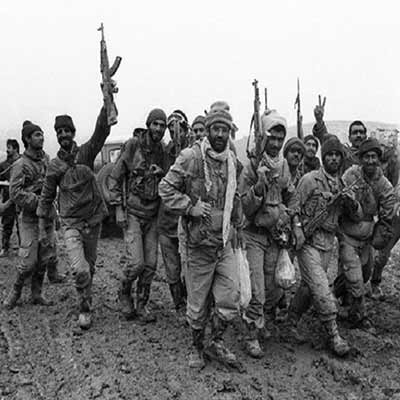Operation Tharallah (as)
Zeinab Ahmadi
267 بازدید
On August 6, 1982, the Islamic Revolutionary Guard Corps (IRGC) and the Islamic Republic of Iran Army launched Operation Tharallah (as) in Qasr-e Shirin, to liberate the heights of that area.
After Operation Ramadan, which was carried out on July 13, 1982, in eastern Basra, the need to expand combat capabilities and rebuild units led to the temporary halting of Iranian military activities to address this shortcoming with new strategies. However, such inactivity was seen as a form of surrender to the Iraqi army. Therefore, the execution of limited operations was put on the agenda. These operations prevented the Iraqi army from inflicting further damage on Iranian forces while keeping the battlefield active, disrupting the enemy’s strategy with continuous and diversionary strikes. In addition, by inflicting higher casualties on the Iraqis and exhausting their troops, these operations prevented Iraqi forces from employing any new tactics.[1]
After the liberation of Khorramshahr in Operation Beit al-Muqaddas (April 30 to May 24, 1982, west of the Karun River),[2] the Iraqis were forced to withdraw from Iranian territory, including Qasr-e Shirin, and positioned in the high-altitude areas overlooking the city, particularly along the northern stretch of the Qasr-e Shirin–Sarpol-e Zahab Road. They would target Iranian forces moving along this road and destroy their equipment. Another reason for conducting Operation Tharallah (as) was to liberate these heights and mountains.[3]
The operational area of Tharallah (as) was located to the north and northeast of Qasr-e Shirin, along the Iran-Iraq border, between Barar Aziz and Parviz outposts. Muhammad Boroujerdi, commander of the IRGC’s Region 7, appointed Reza Mirzaei, who had long served at the outposts north of Qasr-e Shirin and Sarpol-e Zahab, as the executive commander of this operation.[4] Subsequently, the Basij forces from the Hamedan Province were summoned, organized under the Tharallah (as) Battalion, transferred to Kermanshah and after 22 days of training at the Allah Akbar Barracks in Eslamabad, dispatched to the Abu Zar Barracks in Sarpol-e Zahab.[5]
The two phases of reconnaissance was carried out by Reza Mirzaei (the operational axis commander and commander of the Tharallah (as) Battalion) along with company commanders. The first phase included scouting the heights to estimate the number of soldiers needed for the operation. Therefore, two companies from the Vali Asr (as) Battalion of Hamedan Province and the Fath Battalion of Kermanshah were assigned to join and support the Tharallah (as) Battalion. In the second phase of reconnaissance, the Iranian forces infiltrated enemy positions to gather information on Iraqi forces and their equipment.[6]
The area was under the control of Iraq’s Second Army Corps, with the enemy’s 6th Armored Division and 8th Mountain Infantry Division stationed throughout the western and northern parts of Qasr-e Shirin. The number of Iranians that participated in this operation was 540. They were transferred on August 5, 1982, to the Martyr Sadouqi base on the southern flank of the Qasr-e Shirin Road (the operational area).[7]
Finally, Operation Tharallah (as) was launched at 4:30 AM on August 6, 1982, with the code-name “Ya Allah, Ya Allah, Ya Allah”, aiming to liberate several strategic heights in the Qasr-e Shirin axis, around the Iraqi outposts of Pirooz Khan and Qaleh Sefid, and provide the security for the Qasr-e Shirin–Sarpol-e Zahab Road. Two battalions from the Hamzeh and Al-Mahdi (as) brigades of the IRGC, supported by an armored battalion from the 2nd Armored Brigade of Sarpol-e Zahab and an armored battalion from the 2nd Brigade of the 81st Army Division, engaged in the operation. Initially, the Iranian infantry forces attacked from five axes with the support of tank fire, successfully reclaiming six significant hills from Iraqi control. However, due to intense Iraqi counterfire, they had to withdraw from four hills while holding positions on two others.
This one-day operation also moved the Qasr-e Shirin–Sarpol-e Zahab Road out of Iraqi artillery range, ensuring its security.[8] Moreover, the Iraqi supply route from Pirooz Khan to Bishgan Gorge came under direct Iranian observation and fire.[9]
In retaliation for this defeat, the Iraqi army shelled the ruins of Qasr-e Shirin with artillery fire.[10]
Iraq’s losses in this operation included 200 soldiers killed or wounded, the destruction of one tank, three vehicles, and one ammunition depot.[11] On the Iranian side, 85 people were martyred, 115 were wounded, and 18 were captured by Iraqi forces. The bodies of most Iranian martyrs remained on the battlefield. Years later, after carrying out search operations in the area the bodies of some of the martyrs were found yet due to the lack of identification tags, they were buried as anonymous martyrs in various locations across Iran.[12]
[1] Dorudian, Muhammad, Siri dar Jang-e Iran va Iraq (A Review of the Iran-Iraq War), Vol. 2: Khorramshahr ta Faw, Tehran: Markaz-e Motaleat va Tahqiqat-e Jang-e Sepah-e Pasdaran-e Enqelab-e Eslami, 5th ed., 1999, Pp. 36–38.
[2] Rashid, Mohsen, Atlas-e Jang-e Iran va Iraq (Atlas of the Iran-Iraq War), Tehran: Markaz-e Motaleat va Tahqiqat-e Jang-e Sepah-e Pasdaran-e Enqelab-e Eslami, 2000, p. 49.
[3] Mirzaei, Reza, Hamasahha-ye Namdaran-e Gomnam (The Epics of Anonymous Heroes), Tehran: Bonyad-e Hefz-e Asar va Nashr-e Arzeshha-ye Defa-e Muqaddas, 2015, Pp. 808–809.
[4] Ibid.
[5] Ibid., p. 810.
[6] Ibid., p. 812.
[7] Ibid., Pp. 813–814.
[8] Kazemi, Asghar, Bamu (Bamu), Tehran: Vezarat-e Farhang va Ershad-e Eslami, 2000, p. 185.
[9] Lotfollahzadegan, Ali-Reza, Rozshomar-e Jang-e Iran va Iraq (Chronology of the Iran-Iraq War), Vol. 20: Obur az Marz, Tehran: Markaz-e Motaleat va Tahqiqat-e Jang-e Sepah-e Pasdaran-e Enqelab-e Eslami, 2002, p. 553; Dari, Hassan, Atlas Rahnama 7: Kermanshah dar Jang (Guide Atlas 7: Kermanshah in the War), Tehran: Markaz-e Motaleat va Tahqiqat-e Jang-e Sepah-e Pasdaran-e Enqelab-e Eslami, 2005, p. 104.
[10] Rouznamei-e Jomhouri-ye Eslami (Jomhouri-ye Eslami Newspaper), No. 923, August 8, 1982, Year 4, p. 2.
[11] Lotfollahzadegan, Ali-Reza, Rozshomar-e Jang-e Iran va Iraq (Chronology of the Iran-Iraq War), Vol. 20, p. 553.
[12] Mirzaei, Reza, Hamasahha-ye Namdaran-e Gomnam (The Epics of Anonymous Heroes), p. 817.



